As an Amazon Associate I earn from qualifying purchases.
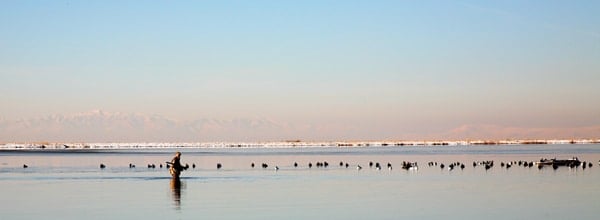
I lay on my back, nestled into a floating layout blind anchored to the bottom of a corner of Utah’s Great Salt Lake. Surrounding me are dozens of plastic duck decoys, mostly painted to look like canvasbacks and bluebills. One sits on the blind with me, attached by a magnet. My shotgun rests in my lap; I’m hoping the ducks think it’s a floating stick. I try to relax as the dawn brightens.
Even flat on my back, the towering Wasatch Range looms in front of me, its snowy peaks blocking the sun’s ascent. Far away, I hear the muted roar of interstate traffic: Commuters on their way to work in Salt Lake or Bountiful. Suckers. Swans honk and yodel as they soar overhead, many well within shotgun range — if only I’d drawn a tag to shoot one. I watch as they pass.
Wisps of fog slide by. Coots chirp and burble just outside the decoys. They make good gumbo, but I did not travel all the way to Utah to shoot a coot. No. I came here to shoot a canvasback, the King of Ducks. I can only shoot one per day, but it will be worth it. Canvasbacks and pintails are my favorite birds to eat, and both are all over this lake right now.
I settle in and listen to the gentle slop-slop of the lake lapping at the sides of my layout boat. I doze, ever so slightly, until the sun finally crests the Wasatch. It is as if the eye of God pierces me — the boat is anchored precisely in line with the sunrise, into the wind, where the ducks will want to land. Hunting will be harder now. I cannot see in front of me, and I can’t shield my eyes for fear of scaring off ducks from the movement. So I lower my cap as far as it will go and listen. My ears will not fail me.
Soon I hear it. A sound like a squadron of F-16 Thunderbirds roaring in for a strafing run. Only these jets are ducks. Diver ducks, to be exact. I grip the stock of my shotgun and ready myself for where I am guessing they will emerge into my now very limited field of view. I guess correctly, and see a flight of six bluebills zoom in from my left. I pop up into a sitting position, shoulder my gun and drop one. It slams into the lake and bobs up belly first. I relax a bit. Wounding a diver duck on big water like this is far worse than wounding a puddle duck in a marsh: When a diver tries to escape, it can swim more than 100 yards underwater, well out of reach of your shotgun. Especially if you are stuck in an anchored boat.
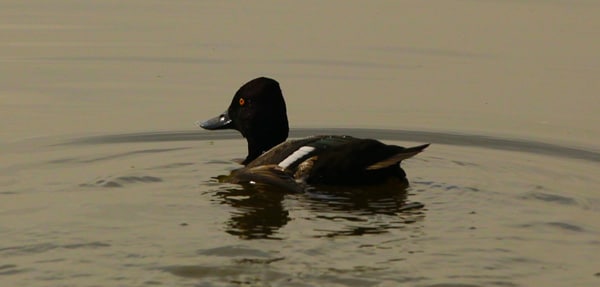
Quiet enfolds me again and I lay there, mesmerized by the sound of the lake and the faraway traffic. This time I don’t hear the jet engine noise until it’s almost too late. Another diver duck roars in from my left, and I only have time for one thought: Lead it, it might be a can! Canvasbacks can fly faster than 70 miles per hour, and you don’t get a second chance at that speed. I pop up, shoulder the gun and practically flick the barrel in front of the speeding bird as I fire.
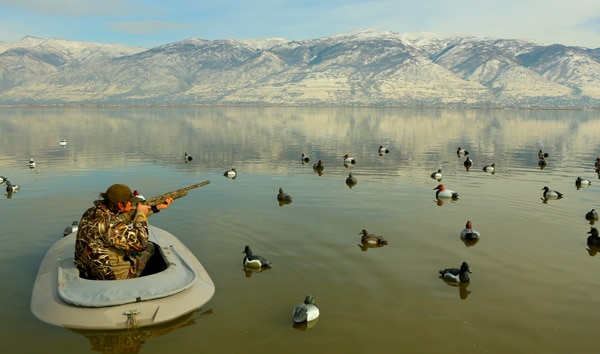
I am genuinely surprised that the bird somersaults into the water, skipping several times like a stone. It does not move again once it comes to a stop. In my head, I play the whole event back in slow motion. Was that a canvasback? I think it was. A hen, maybe. But I am chained to this boat. My friends at Camp Chef, who invited me out to this hunt, were waiting back onshore. The plan was to motor out and pick up the birds when I was done.
I watched as the bluebill, a spoonie I’d shot earlier and the possible can drifted away from me. Seagulls began to circle. Gulls will peck at dead ducks, and while I don’t begrudge them a meal, I do not kill ducks for them. I start to fret, and sit up, waving my arms to attract the attention of Matt and Tony Smith, the guy who made this floating blind I was laying in. No response. I am too far away. Damn.
Then I remember that Tony told me that this part of the lake was never more than waist deep. Screw it. I hauled myself out of the blind and was immediately happy that I only sank up to my thighs. This wasn’t so different from where I hunt in California. You just need to walk carefully, lest you step into a hole and flood your waders. I slogged toward the bobbing ducks. As I gained ground on them, the seagulls backed off. Good.
I picked up the spoonie first, then the bluebill. The last duck was just a few feet away. As I drew closer, I saw: Definitely a canvasback. Sadly a hen — I prefer to shoot drakes — but a can is a can. Finally I grab it in triumph, then I see why it was stone dead on the water; I’d hit it in the head with half the pattern. No trip to the taxidermist for this duck, but that’s as it should be. My trophies are at the table, and none are greater than a canvasback, roasted in a scorching oven and served medium-rare with fried hominy and a red currant sauce.
I shot my limit of ducks that day, and even got myself a fat drake pintail to boot. But this one canvasback made the whole trip worth it. Canvasbacks are more than ducks, more than table fare. They are memories.
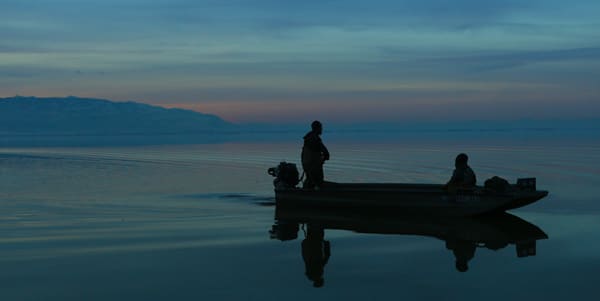

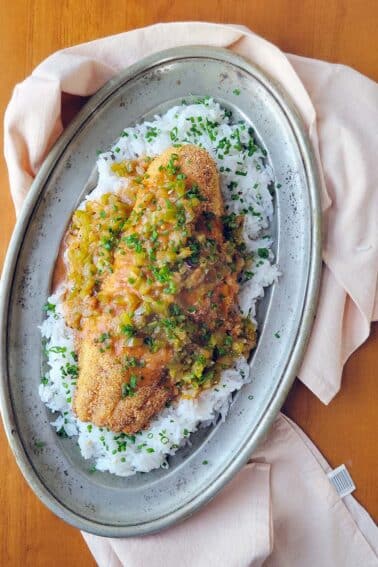


Do you have the name and # of a GREAT guide for the GSL. Visiting my son in Bountiful 1st week of Dec. would love to take him.
Specs, sprig a close second, mallards (if they’ve been eating right), then teal*, then cans 🙂
*Teal stuffed with wild rice-yum (I know, I know: we almost never stuff a bird–makes ’em drier than a popcorn fart, usually)
Hank,
I read your story and am in just as much awe of the Canvasback as you. I was told that that particular duck was the best table fare. I had serious doubts. After harvesting my first last year I can honestly say they are the best. Such a shame they were almost hunted to extinction. We are heading out next week for our turn at them.
I share your love for the king of ducks. Those swans are quite delicious as well. I believe Nevada still has some leftover tags. Let me know if you’d like some advice on where to go for a Can/Swan combo hunt here in the Silver State. Your writings and recipes are terrific. I wish there were more representatives like you in the hunting community.
Love the blog. Enjoy the pics. (Where’s Holly?) Living vicariously.
Great story. Great pics. Great setting….and Great shooting!
Great write up. I love hunting Pochards. It’s unfortunate that most people don’t realize just how good Canvasbacks, Redheads, and Ringnecks are as table fare.
Sweet! My group got 2 cans this Saturday. Drake and a female. Both deeked up hard. Damn they’re a big duck. It’s my first time seeing a drake up close. Not quite in full plumage, but still regal enough.
And you leave the lake with ducks that have already been brined!